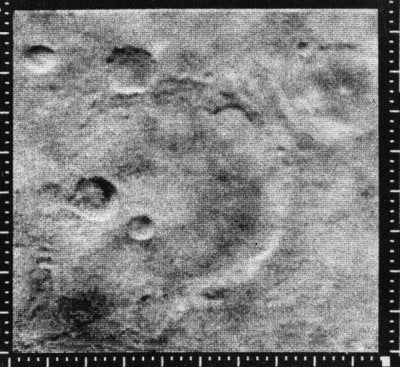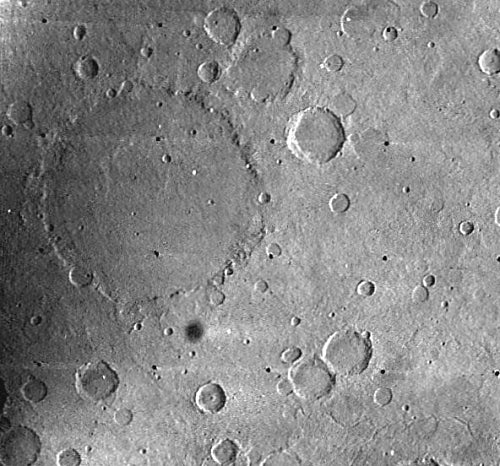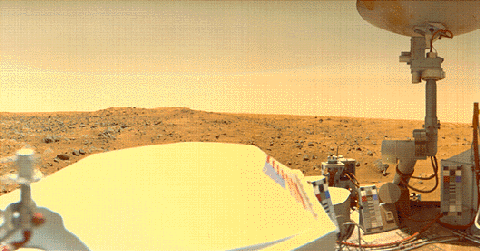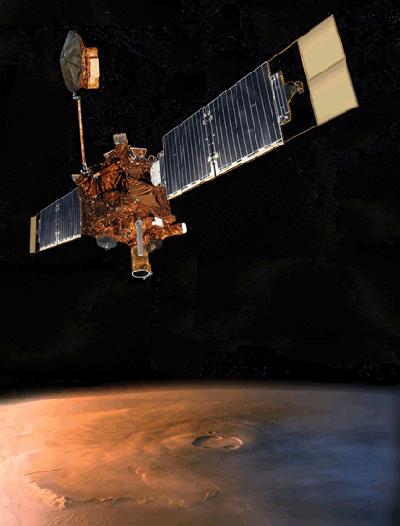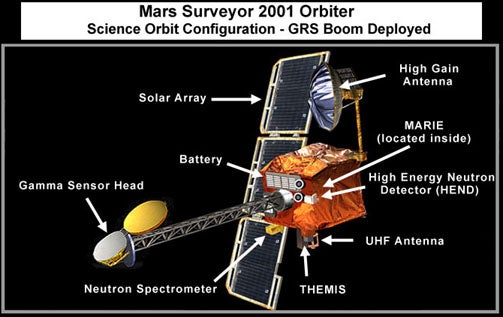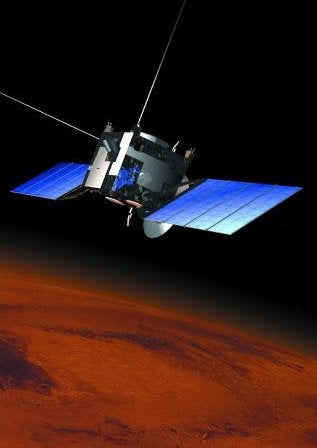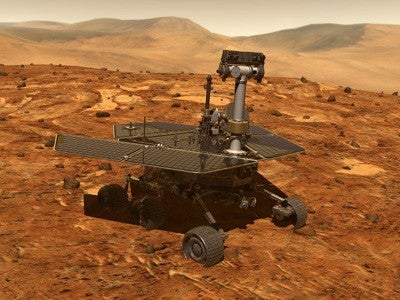Unnamed mission — USSR
The USSR launched two Mars probes on October 10 and 14, each carrying a minimal amount of scientific equipment. Both launches were unsuccessful as the third stages of the rockets failed to ignite. The two probes crashed to Earth minutes after launch.
Due to the political climate of the times, the USSR kept these missions a secret and did not even release to the West a name for the spacecraft. The missions are commonly referred to as “Korabl 4 and 5,” “Mars 1960 A and B,” or “Marsnik 1 and 2.”
Sputnik 29 — USSR
The Soviet Union attempted three separate launches with similar spacecraft. On October 24, Sputnik 29 quickly exploded just after reaching low Earth orbit. On November 1, Mars 1 successfully entered the proper trajectory toward Mars. Three days later, the fourth stage of Sputnik 31’s rocket, failed to ignite, and the spacecraft remained in low Earth orbit until returning to Earth and being destroyed two months later. Mars 1 reached the Red Planet on June 19, 1963, but the scientific equipment failed on March 21, so it was unable to communicate any data upon its historic arrival to Mars.
Mariners 3 and 4 — United States
On November 5, 1964, Mariner 3 launched as the United States’ first attempt for the Red Planet, and it, like the Russians’ first attempt, failed. The protective cover over the spacecraft did not separate on schedule. This extra mass caused the spacecraft to drift off course and prevented the solar arrays from extending out. Not being able to gather additional, needed electricity, the batteries drained, and all communication was lost.
Mariner 4 launched November 28, set with a modified protective cover to prevent the same ignominious fate of its predecessor. Mariner 4 arrived near Mars on July 14, 1965. Within 9,800 km of the surface, the spacecraft shot the first close-up images of the Red Planet. Other experiments revealed Mars’s atmospheric pressure to be less than 1% that of Earth’s. After successfully completing its job of studying the Red Planet, Mariner 4 orbited the sun and headed back toward Earth in 1967.
Zond — USSR
The USSR launched just one Mars probe in 1964: Zond 2. After a successful launch, the spacecraft’s communications systems failed in April 1965, thus both the mission and the spacecraft itself were rendered useless.
Mariners 6 and 7 — United States
NASA launched Mariners 6 and 7, both similar to the first Mariner spacecraft, but with more advanced technology. Mariner 6 launched on February 24 and reached Mars on July 31, 1969 and took 75 images of the martian surface. Mariner 7 launched on March 27. Despite suffering an exploded battery, the spacecraft rebounded to take 126 pictures of Mars. Mariner 7 came within 3,400 km of Mars on August 5, 1969.
The images taken by the two Mariner spacecraft supplied a different view for scientists than Mariner 4. Rather than a moonlike surface, the new pictures showed Mars’s cratered deserts, depressions with no craters, and collapsed ridges. The larger and more advanced instrument stock allowed the two spacecraft to conduct studies of the atmosphere and its chemical composition. Even the communications system allowed for transmissions 2,000 times faster than Mariner 4’s capability.
Mars 1969A and Mars 1969B — USSR
The Soviet Union planned and launched two identical Mars orbiters, Mars 1969A and Mars 1969B. Launched just five days apart, the two flew for a collective total of about 8 minutes. 1969A’s engine shut down 7 minutes into the flight and exploded, pieces landing in the Altai Mountains in southeastern Siberia. 1969B didn’t even make it that far, crashing to Earth just 3 km from the launch site. Both were equipped with cameras and other equipment to survey the martian surface and atmosphere.
Cosmos 419, Mars 2, and Mars 3 — USSR
The Soviet Union launched three spacecraft to Mars in 1971. The first, later named Cosmos 419, launched on May 10. Minutes after liftoff the spacecraft turned to the east and entered orbit around Earth. At this stage, the fourth rocket was supposed to fire and start the probe on a course for Mars. Due to a mistake while setting the rocket’s timer, it failed to go off as planned. Originally expected to ignite at 1.5 hours, the timer was set to 1.5 years. Two days after liftoff, Cosmos 419 returned to Earth and was destroyed. Interestingly enough, the USSR denied the claim that Cosmos 419 was ever headed for Mars. However, the subsequent identical vehicles that successfully reached Mars were labeled Mars 2 and 3.
Mars 2 blasted off on May 19, followed nine days later by Mars 3. Both functioned as expected. Mars 2 reached the Red Planet and began its orbit on November 27. Its lander deployed as planned but lost contact. Scientists suspect it crash-landed due to the raging dust storm on the surface. Mars 2 enjoyed a life of 150 orbits around the planet, whereas its partner, Mars 3, lasted just seven before failing. However, its lander successfully arrived on the surface, despite the severe wind and dust. The camera started its scan of the surface. Twenty seconds later, all communication with the lander was lost, and no images were transmitted.
Mariners 8 and 9 — United States
To take better pictures, and conduct a more comprehensive study of Mars, NASA built two spacecraft that could stop upon arrival to the Red Planet and enter its orbit. This type of mission would allow for higher quality images of the entire surface. Mariner 8’s mission ended abruptly and created quite a splash when it dove into the Atlantic Ocean, minutes after launch on May 9. Its partner though, Mariner 9, successfully launched on May 30 and became the first spacecraft to orbit another planet. After a lengthy and blurring dust storm finally subsided, Mariner 9 began its scrutiny of the Red Planet. By two weeks shy of a year, Mariner 9 had photographed 80% of the martian surface and transmitted 7,329 images revealing everything from riverbeds, to extinct volcanoes, to canyons. This remarkable spacecraft also found, among other things, evidence of wind and water erosion, weather fronts, and fogs. Not limiting its technological capabilities just to Mars, Mariner 9 also analyzed the planet’s two moons, Phobos and Deimos. This spacecraft surpassed all expectation and stands out as one of the most successful missions to Mars.
Mars 4, Mars 5, Mars 6, and Mars 7 — USSR
The Soviet Union launched two orbiters and two landers. Mars 4, an orbiter, launched on July 21. Mars 5, another orbiter, launched four days later on July 25. The landers, Mars 6 and 7, lifted off on August 5 and August 9. Each of the spacecraft launched successfully and all set a course for the Red Planet. Unfortunately, perhaps not surprisingly, none of the four accomplished what they set out to do. Mars 4 sailed right on past the planet on February 10, 1974. Mars 5 entered orbit a few days later, took a few photos, then vanished. Mars 7 neared its target before Mars 6, but would never get closer than 800 miles from Mars. Mars 6, entered the martian atmosphere on March 12, deployed its parachute, and was never heard from again.
Vikings 1 and 2 — United States
Just as Mariner 9 was revealing the presence of water on Mars, NASA was working on a concept called “Voyager” to prove the existence of life on the Red Planet. Ultimately, this program’s exceedingly high ambitions were equal to the cost, and it fell by the wayside. Some scraps from the plans, though, were saved and used as a foundation for the Viking missions. These two spacecraft were both significantly lighter and less expensive. The landers were equipped with a camera, seismometer, a weather station, an x-ray fluorescence instrument, and a biology laboratory. The laboratory was designed to test soil samples to determine if there was evidence of life in them. Twenty-twenty hindsight guaranteed the results to be inconclusive.
The orbiter’s sole function was as a transporter for the lander. The instruments on the orbiters were geared specifically for assisting the lander’s descent and placement. Cameras, infrared mappers, and atmospheric water detector helped scientists pick the ideal location for the landers.
The original 1973 launch for these two spacecraft was delayed until 1975 because of financial and technical concerns.
Viking 1 launched on August 20 and its twin on September 9. Viking 1 began orbiting Mars on June 19, 1976, and the lander separated one month later on July 20, 1976. It landed three and a half hours later. The camera worked properly, but the seismometer did not.
On July 28, Viking 1’s robotic arm reached down, scooped up some soil from the surface, and transferred it to the biology laboratory for study. The gamut of tests failed to conclusively establish the presence of life on Mars. Viking 2’s tests, though taken 4000 miles from Viking 1, were similarly inconclusive.
The two landers remained on the planet after finishing the tests. Viking Orbiter 2 developed a propellant leak in 1978 and stopped function on July 25 of that same year. Its lander ceased operations two years later on April 12, 1980. Months later, Viking Orbiter 1 ran out of propellant on August 7, 1980. Its lander fell silent on November 13, 1982.
Combined, the Viking orbiters and landers returned more than 50,000 high-resolution photos of Mars.
Phobos 1 and Phobos 2 — USSR
Almost 15 years after the Mars 4, 5, 6, and 7 fiasco, Russia recommitted itself to the Red Planet. Named after one of Mars’s two moons, Phobos 1 and 2 were to utilize advanced technology and an impressive scientific payload to conduct the most comprehensive studies of Mars in Russian space history. The twin spacecraft were launched on schedule on July 7 (Viking 1) and July 12 (Viking 2). These two were to be the first in a series of Russian Mars efforts. All was going according to plan until August 30, when Phobos 1 received a command to turn its solar array away from the sun. Three days later, all communication with the spacecraft was lost.
Then, on January 29, 1989, Phobos 2 arrived near its namesake, Phobos, and embarked on its own orbit of Mars. Four days before it was to send a pair of landers to the surface, Phobos 2 conducted a photo session, to scout possible landing sites. Two days later, on March 27, 1989, it attempted another session. Phobos 2 was never heard from again after it failed to turn its radio signals back to Earth. It is believed that a computer error caused the failure.
Leading up to the failure, though, Phobos 2 successfully made significant measurements of martian particles and the fields environment. Fortunately, this important information was gathered and transmitted before its demise.
Mars Observer — United States
NASA’s Mars Observer program’s struggles in the early stages of development proved an ominous sign for the future. Originally scheduled for launch in August 1990, NASA pushed the $900 million project back to September 16, 1992, as a result of the technical problems and the explosion of Challenger in 1986. Hurricane Andrew prevented the Sept. 16 launch, so it was rescheduled yet again and launched on September 25.
Observer took its first image of Mars in July 1993, after a successfully mundane trip to the Red Planet. One month later, though, on August 21, 1993, it received the command to temporarily shut down its transmitter so it could prepare its propellant lines for an engine firing to begin its orbit. The transmitter never restarted, and NASA tried in vain for one year to reacquire contact with the spacecraft.
The suspected cause of the failure was that some propellant had leaked through a valve that was not intended to operate for 11 months after launch. If this theory is right, then the Observer sailed right past its target, and entered an orbit around the sun.
Mars Global Surveyor — United States
Attempting to rebound after the expensive Mars Observer debacle, NASA committed to design a “faster, cheaper, better” Mars spacecraft. Whereas Observer was equipped with an extensive scientific payload, the new design, Mars Global Surveyor, would have a much more slimmed down inventory with just a camera, a magnetometer, a thermal emissions spectrometer, and a laser altimeter.
Scheduled for launch in November 1996, it took off on November 7, already an improvement over Observer. But MGS’s trip was more eventful than Observer’s, if only a little. Quickly approaching Mars, MGS was commanded to unfold its solar arrays. One of them did not properly unfold, bent just out of position. Besides causing a slight delay in the spacecraft’s aerobraking schedule, the solar array still generated full power.
MGS started its primary orbit around Mars on September 11, 1997, and lowered into the upper reaches of the martian atmosphere six days later. The damage to the solar arrays was discovered on October 11, but after three weeks of investigation, MGS resumed aerobraking. In March 1999, the Global Surveyor started mapping the Red Planet. Having completed mapping 3 years and 3 months after launch, MGS inherited the job as communication satellite for landers. It remains in orbit and continues to take clean, crisp images of the martian surface.
Mars 96 — Russia
Originally slotted for a 1994 launch, economic crises in Russia forced the mission to be rescheduled and slimmed down. Mars 96 was to be a Mars orbiter that would send two landers and two penetrators to the surface. The landers would arrive on airbags, similar to NASA’s Pathfinder. After settling on the surface, the penetrators would fall to the surface and the instruments would be buried in the soil. A radio transmitter would stick out of the ground to send information from below the surface back to the orbiter.
On November 16, Mars 96 launched without complication. From an Earth orbit, a small liquid-fueled rocket was supposed to send Mars 96 to its target planet, but it didn’t and the spacecraft remained in Earth orbit before reentering Earth’s atmosphere and plunging into the Pacific Ocean.
Mars Pathfinder — United States
The second mission under the umbrella of NASA’s new “Discovery” program – intended to get the highest quality spacecraft into space in the least amount of time from concept to design, at the lowest possible cost – was Mars Pathfinder, a single lander with a six-wheeled rover, named Sojourner, attached. It launched on December 4 and enjoyed an uneventful trip to Mars. The lander was deployed on July 4, 1997. 300 meters above the martian surface, the computer commanded four airbags to inflate, surrounding the Pathfinder and protecting it from the jolting landing. After three rockets brought the descent to a halt 30 meters above the surface, the spacecraft fell like a ball dropped from the hand of a child the rest of the way. It finally rolled to a stop after bouncing nearly a dozen times.
Once stationary, Pathfinder deflated and retracted its airbags. A rover, a camera, and an antenna emerged from the blossoming solar arrays. Before Sojourner could roll down the exit ramps to the ground, parts of an airbag blocking the path away from the lander had to be retracted. On July 6, 1997, the first Mars rover rolled down the ramp onto the red surface. Both instruments on the rover, a camera and an alpha x-ray spectrometer surpassed all expectation and even operated well beyond their expected lifetimes of one week.
On September 27, 1997, Pathfinder stopped transmitting. No signals were again heard from Pathfinder after October 6.
Nozomi — Japan
Japan joined the United States and Russia in exploring Mars, after almost four decades of seemingly exclusive access to the Red Planet by the two giant countries. Japan’s spacecraft of choice for studying Mars was originally called Planet B before being changed to Nozomi, which is Japanese for hope. Unlike the slimmed down NASA “Discovery” projects, Nozomi carried with it 14 different science instruments. Such a significant payload will be used for an extensive, ongoing study of the Red Planet.
It launched on July 4, 1998; one year after Mars Pathfinder’s lander began its historic descent to the martian surface. Originally planned to inject itself onto the interplanetary trajectory to Mars on December 20, the rocket responsible for setting it on the right course did not fully fire. The spacecraft thus lacked the necessary velocity to reach Mars as planned. Off course, but not out of touch, Nozomi received commands to orbit the sun three times before it re-encountered Earth in December 2002, and later this summer on June 19, 2003. It is expected to reach Mars in July 2004. Once in orbit around the Red Planet, Nozomi will begin its study of the martian upper atmosphere and its interaction with the solar wind to help develop technologies for use in future planetary missions.
The mission is planned to continue sending data on Mars from December 2003 to October 2005, and possibly longer.
Mars Surveyor 98, Mars Climate Orbiter, and Mars Polar Lander — United States
Hoping to gain momentum after the successful Mars Pathfinder mission, NASA readied two other spacecraft, Mars Surveyor 98 lander (Mars Polar Lander) and an orbiter (Mars Climate Orbiter) for launch in 1998. The orbiter mission would launch first in December 1998. It carried just two scientific instruments for studying Mars: a color imager to take pictures of the martian surface, and an instrument to measure the temperature and pressure at various locations in Mars’s atmosphere, and to determine the distribution of dust and water vapor in the atmosphere. Starting more like Mars Observer than Pathfinder, the original launch date, December 10, for the orbiter had to be bumped just a day as a result of a computer problem during countdown. It lifted off without complication on December 11.
The lander lifted off as scheduled on January 3, 1999. It was equipped with an instrument called Deep Space 2 (DS2), two penetrators similar to those on the failed Mars 96 mission.
Nine months after lifting off from Earth, the orbiter arrived to Mars on September 23, 1999. Unfortunately, though, a navigational error prevented it from slowing down as it neared the martian atmosphere and it crashed to the surface. Investigators discovered that a gross miscommunication between Jet Propulsion Laboratory navigation team and the industrial partner, Lockheed Martin, was the reason for the crash. The JPL team requested thruster impulse data in metric units of kilogram-meters per second, but Lockheed Martin provided the numbers in pound-seconds. The factor of 4.5 difference between the two numbers is enough to severely alter the course of the spacecraft.
The Mars Polar Lander was inexplicably lost during its attempted landing on Mars, Dec. 3, 1999. An investigation by NIMA (the National Imagery and Mapping Agency), a top secret spy imagery agency under the Department of Defense, may have found the Polar Lander intact on the martian surface. The results of this study are under review by NASA and NIMA researchers. The two agencies are working together to resolve a number of technical questions.
Mars Odyssey — United States
Originally the second part of a two part Mars Surveyor 2001 project, Mars Odyssey became the sole point of emphasis after the lander spacecraft was cancelled. It launched on April 7 and enjoyed a relatively harmless trip before it reached Mars on October 24. Over the next few months, used aerobraking to get into its main orbit of Mars. During its orbit, Odyssey conducts detailed mineralogical analyses of the Red Planet’s surface and measures the radiation environment. The primary science goals include acquiring data to help determine whether the martian environment was ever conducive to life, to characterize the climate and geology of Mars, and to study potential radiation hazards to possible future astronaut missions. Data will be collected from orbit until July 2004, when Odyssey will remain as a communications relay for future Mars missions until October 2005.
Mars Express — European Space Agency
On June 2, a Soyuz rocket liftted off from the Baikonour Cosmodrome and carried with it the European Space Agency’s first Mars-bound spacecraft. Mars Express marks ESA’s inaugural Mars mission and is also the first in a series of at least six international missions destined for the Red Planet between late 2003 and early 2004.
After discovering a fault in one of Mars Express’s electronic modules, engineers delayed the launch — originally scheduled for May 23 — to June 6. The new launch date of June 2 results from the timely efforts of the project team to fix the problem.
At the end of its six month journey to the Red Planet, Mars Express will deploy Beagle 2, a lander, to perform exobiology and geochemistry research on the martian surface. Beagle 2’s scientific payload includes a panoramic and wide field camera, a robotic arm to pick up and analyze rocks for traces of organic matter, and a small electronic that will scatter across the surface to burrow into the ground to collect samples for a gas analysis system. All of these instruments will help scientists discover evidence for the possibility of life on Mars — at least, within range of Beagle 2’s landing site.
Beagle 2 will also act as a seeing-eye dog for other “incoming” international Mars lander missions from 2003 to 2007.
Mars Express will begin orbiting Mars after Beagle 2’s descent to the surface. In orbit, the spacecraft will put to work its impressive scientific inventory of seven instruments. The total stock of technology is capable of conducting the most thorough search for water on Mars ever carried out.
The Mars Express mission is expected to last about two Earth years, but will assist future Mars missions after completing its own scientific objectives.
Mars Exploration Rovers — United States
As discussed in Jim Bell’s article “Blazing a new path” in the August 2003 issue of Astronomy, the rovers will study the climatic and geologic histories as well as the water history in Gusev Crater and Meridiani Planum on the martian surface. As Bell states, “The primary goal of this mission is to better understand the evolution of places where conditions may be favorable for preserving evidence of life and pre-life processes.”
One of the fascinating aspects of this mission is the active collaboration between the stock of instruments on board the rovers. With each instrument program to interact and help another, the rovers will closely resemble a geologist or archaeologist scouring the martian surface. Even the wheels can conduct scientific experiments. The rovers are even programmed to function on their own, making intelligent and safe decisions about where and how to drive as well as obtain scientific measurements.
The team in charge of this mission has carried the synergistic philosophy all the way to communication. The rovers will not only keep in touch with their delivery orbiter, but also connect with Odyssey and Mars Global Surveyor both expected to still be orbiting Mars when the rovers roll onto the surface, the first on January 4, 2004, and the second three weeks later on January 24. By working with the three different orbiters, the rovers will be able to send almost three times the amount of imaging data to Earth.
Planned missions to Mars include: NASA’s Mars Reconnaissance Orbiter, scheduled for July 2005; NASA’s Mars 2007, scheduled for late 2007, contains a mobile scientific laboratory and small scout missions; the French Space Agency’s Netlanders, also scheduled for late 2007; and NASA’s Mars 2009, late 2009, a possible communications satellite.

